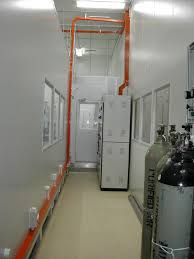Why Laboratory Designs Need to be Sustainable
Why Laboratory Designs Need to be Sustainable
Laboratory design is among the most challenging work we can do as mechanical engineers. Not only we have to consider how best we air condition the space, but we also need to consider the different elements of the working areas and requirements.
Laboratory safety is the topmost critical consideration, fit for purposes follow by sustainable and circular. Optimal laboratory designs would include all stakeholders, especially the laboratory manager and technicians that will be using the laboratory. Who would know better than them to improve productivity and minimising errors?






Here are the steps we took when designing the Undergraduate Microchip cleanroom.
Pre-planning with Stakeholders
We conducted four rounds of stakeholders workshops, the first group being with the professors, lecturers, tutors, health and safety officers. Second, with graduate students, third the undergraduate students; and final workshop after our preliminary design, we invited all stakeholders to review and scrutinise the location, layout, utilities, storage, general and maintenance access.
During these workshops, we assigned an ultimate responsible person from the university to liaise among the different participants.
Criteria identified and resolute to include
- bench type including depth and height
- equipment and computers placements
- the proximity of equipment to minimise movement or travel
- writing space and admin area
- work surfaces types
- lighting types and levels
- ventilation and cross-contamination risks
- air conditioning temperature/ relative humidity
- workflow, access, sitting and ergonomics
- flexibility, adaptability and ease of expansion
Safety First
A critical component of all laboratory design is life safety; be it a microchip or microbiological laboratory. Laboratory safety must not be compromised, for example; we implemented a buddy system, and emergency duress push buttons were strategically located in several areas of the laboratory.
We marked all exits clearly, and alternative escape routes provided to ensure safe escape from the laboratory during an emergency. Along the escape paths, we installed emergency showers/ eyewash stations and fire extinguishers. We provided first aid kits and defibrillators prominently.
Note: AS/NZS 2243.3 Safety in laboratories – Microbiological safety and containment, is the legislative requirement for the constructions and operation of microbiological laboratories.
Why Laboratory Need to be Sustainable
Laboratories consume a massive amount of energy and many other resources. Taking, for instance, to maintain the cleanliness of the cleanroom; the air change within is much more than offices. Microbiological physical containment will require additional filtration and disinfectant requirements. Also, the amount of outside introduce into the laboratory is large; many require 100% outside air ventilation.
Laboratories usually operate 24 hours a day, seven days a week. Unlike offices, critical laboratory processes and fume hoods run continuously. In the instances when the fume hoods are not in use, the sash is lowered to minimum opening to mitigate airflow requirements. Air change rates may be reduced overnight and increase the next day based on the recovery time.
When a laboratory is not sustainable and expensive to operate; there may be a compromise on many safety features in the name of reducing operating cost. A typical laboratories use almost five times more energy than the offices.
Laboratory sustainability saves money.
Laboratory Best Practices
Cleaning
Both microelectronic cleanrooms and microbiological physical contained cleanrooms require daily cleansing. All worktops and equipment cleaned and sanitised daily.
Personal Protective Equipment (PPE)
Needs to check PPE regularly. Gloves, eyes and face protection, and footwear not damaged.
Emergency Washing Stations
Eye and shower stations regularly maintained to prevent contamination risks and in right operating conditions.




Refrigerators, Freezers and Inventories
All inventories in the microbiological laboratory stored in refrigerators and freezers checked for expiry and disposed of appropriately.
Maintenance
Plan preventive maintenance to ensure all safety equipment. Mechanical systems, including defibrillators and charged and in right operating conditions.
Calibration of testing equipment shall be part of the planned maintenance.
Once again, laboratory sustainability save money!
Case study: An Undergraduate Microchip Fabrication Facility (Click to download pdf)

